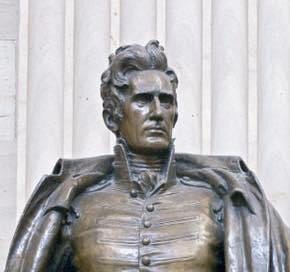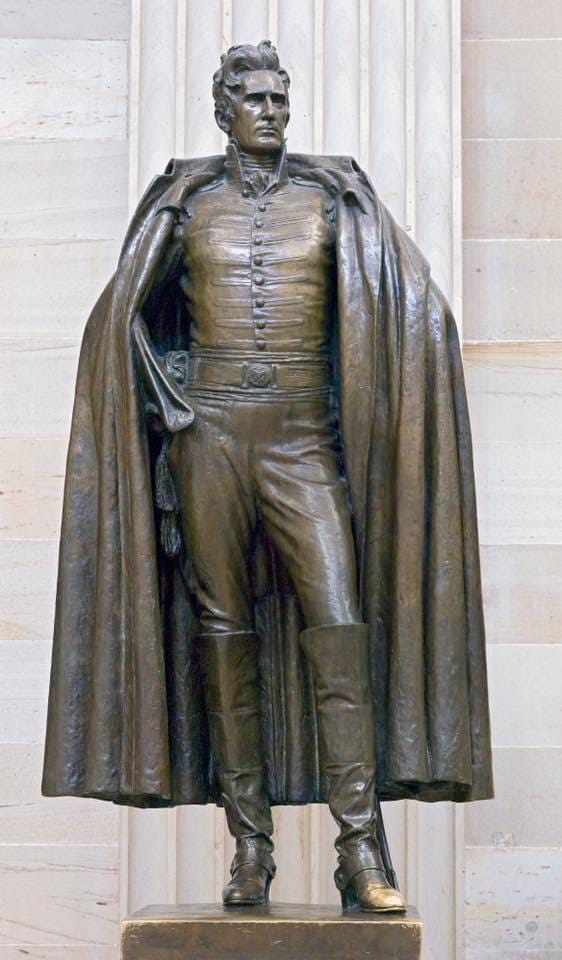Born in the Waxhaws region in 1767, Andrew Jackson is claimed by both North and South Carolina as a native son. At the age of 21, Jackson moved west, to a region that would soon become the state of Tennessee. It is the state of Tennessee that donated the statue of Andrew Jackson that stands in the U.S. Capitol as one of the two statues from each state that make up the National Statuary Hall Collection.
The subject of the other statue from Tennessee is a man Jackson once challenged to a duel. Neither man was killed in that duel, however another man that faced off against the man who would be nicknamed “Old Hickory” was not so lucky. The dueling nature of the man who would be elected the 7th President of the United States will be addressed later on in this piece.
Another subject of one of the statues in Statuary Hall was Jackson’s Vice President, John C. Calhoun, who resigned his Vice Presidency…hmmm…let’s not be too hasty in judging Andrew Jackson. Just because so far it’s been said that he got into duels and his Vice President resigned—that doesn’t mean he doesn’t have some positives to confront the negatives…
Actually, another subject of a statue in the Hall was a close friend of Jackson. It was Sam Houston. There may be other connections to subjects in the National Statuary Hall Collection, but that is all for now.
Let’s get back to Andrew Jackson’s beginnings. His father died shortly before he was born. His widowed mother was left to raise three sons, one a newborn, alone. When the American Revolutionary War reached the Carolinas, the Jacksons paid a high price. Andrew’s older brother Hugh died of heatstroke in 1779, after a battle. In 1781, Andrew and his brother Robert who had joined the patriot cause, were captured by the British. Andrew was only thirteen.
During their captivity, the Jackson brothers were mistreated and contracted smallpox. Robert would not survive. He died shortly after Mrs. Jackson had arranged for their release. Andrew had been slashed by a British officer when he refused to polish the officer’s boots. Young Andrew would survive, but soon after he was well, his mother volunteered to aid sick soldiers in Charleston where she contracted cholera and died. Orphaned at age fourteen, Andrew Jackson unsurprisingly would hold a lifelong hostility towards Great Britain.
With rather a piecemeal form of education, as many at the time had, young Andrew Jackson apprenticed with a saddle-maker, taught in the local school a bit, and then worked in the law office of Spruce McCay where he learned enough law to be admitted into the North Carolina bar in 1787.
Young Mr. Jackson knew enough about the law to get work in the frontier towns. He soon moved west to what was soon to be the state of Tennessee. He boarded at the home of Rachel Stockly Donelson, where he met her daughter Rachel, who would become his wife and lifelong love.
Jackson would find himself in many fights defending Rachel’s honor. Rachel had been in a bad marriage, and although she thought she was divorced when she married Andrew in 1791, it turns out she wasn’t. Legal mayhem in the newly shifting jurisdictions were to blame. The Jacksons married again in 1794, but this legal technicality would dog them Rachel’s entire life.
Amazingly, when Andrew Jackson ran for the U.S. Presidency in 1828, this confusion about Rachel’s marital status at the time she married Andrew, was a major issue raised by Andrew Jackson’s opposition, while the fact that he had killed a man in a duel in 1806, was not!
The reason for duel between Charles Dickinson and Andrew Jackson had its roots in a horse racing bet, however the anger towards each other escalated as rumors mounted. Dickinson was an excellent marksman, but although Jackson was shot only inches from his heart, he survived to shoot a deadly shot, that would leave his opponent dead by the next day. Jackson carried the bullet inside him his entire life, which caused him health problems and served as a reminder of the deadly duel.
Getting back to the years leading up to Jackson becoming president…Andrew Jackson was elected as Tennessee’s first U.S. Congressman in 1796, but was soon elected by the state legislature to be the U.S. Senator of Tennessee in 1797. He soon resigned, claiming disgust with the John Adams’ administration, and returned home where he was elected a judge of the Tennessee Supreme Court. He then sought to be commander of the Tennessee militia, and was elected in a close race again John Sevier, the former Governor of Tennessee. (John Sevier, is the subject of the other statue from Tennessee in the National Statuary Hall Collection, who Jackson challenged to a duel, when Sevier accused Jackson of adultery, by which he meant to dishonor Jackson’s wife Rachel because of the questionable status of divorce at the time of her marriage to Andrew.)
Hmm…and we think politics often gets nasty and childish today? I’ll post more about that duel in a separate post.
When Great Britain began to cause trouble on the seas for United States of America, and threatened settlements on American soil and the surrounding areas of the new nation, America fought back. The Tennessee militia, with Andrew Jackson in charge offered their services to the Federal Government. The offer was not accepted while the warring was taking place in the North, but it soon became clear that Great Britain had its eyes on the South. Control of the Mississippi would weaken the budding nation, and perhaps kill it. Jackson and his militia received directions to head south to Natchez to stop the British. Jackson’s hatred of the British had not waned over the years since his Revolutionary War losses, and he was anxious to beat them back across the ocean, or leave them here in a lifeless form where they could no longer cause trouble.
The beginnings of stopping the British was the Creek War which was fought in what is now Georgia and Alabama. The Creek Indians were in a sort of civil war among themselves, some deciding to fight with Jackson and others joining the British. They were difficult violent times, and settlers were massacred and Creek Indians were massacred. During one attack, a ten-month- old baby from the Creek tribe was left orphaned. Andrew Jackson adopted Lyncoya, and sent the baby home to his wife Rachel to be raised alongside his nephew, who the Jacksons were also raising after Rachel’s brother’s death.
After victory in the Creek battles, Jackson and his men moved further south and west where he and the variety of fighters he had assembled were victorious in the Battle of New Orleans. Jackson lost well under one hundred men, and the great army of Britain lost well over two thousand!
This masterful success would bring fame and national pride to General Jackson that would lead to the U.S. Presidency in 1828. His behavior towards his men during this battle, also earned him the nickname “Old Hickory”, by which he would be affectionately known among friends and followers for the rest of his life and beyond.
In 1823, Old Hickory was again elected to the United States Senate, representing Tennessee. There was soon a call for him to run for president. He did not think he was suitable material for the presidency at first, but eventually succumbed to the calls for him to run. He lost in an extremely tight race against John Quincy Adams. The Senate had to break the tie because no candidate received enough of the Electoral College votes.
Jackson ran again in 1828, and this time he won. He was known as the president of the “Common Man”. Sadly, his lifelong love Rachel did not make it to the White House with him. She died of a stroke shortly after he was elected and before his inauguration. Jackson blamed some of his opponents for her death, because the election had been extremely nasty towards Rachel, and had upset her deeply. Her years ago divorce that was not judicially proper at the beginning continued to haunt the Jacksons. (Crazy, isn’t it??)
Andrew Jackson’s presidency started in a raucous manner at the White House, where supporters of Jackson flooded the executive mansion and the grounds. Perhaps it was a symbol of Jackosn’s presidency. Jackson remained stubborn and true to those who had elected him. He did not back down from what he believed the correct positions. He fought with his Vice President Calhoun over tariffs, over which Calhoun resigned. Jackson fought to shut down the Second Bank of the United States, which he successfully vetoed legislation passed by Congress right before his election to his second term, and he still was reelected president.
Jackson was the first president on which an assassination was attempted. It was during a funeral service of a Congressman. Amazingly, the pistol of the would-be assassin did not fire, at which point 68-year-old Jackson proceeded to beat the man with his cane!
Jackson did sign the Indian Removal Act and held slaves. The past, like the present is complicated and filled with wrongs. It’s important to learn our history so we can learn from it. Statues remind us of people and events that should not be forgotten.
Diana Erbio is a freelance writer and author of “Coming to America: A Girl Struggles to Find her Way in a New World”. Read more in her series Statues: The People They Salute visit The Table of Contents and the Facebook Page. (I’ll be adding to the Substack Table of Contents as I transfer the Blog Posts. Please subscribe to this Substack 😊🇺🇸🤓)




I love the longer story, probably easy with 'old hickory' since there he provided much material. An amazing man, thank you!
A great story Diana!